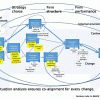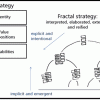Strategic advice to leverage new technologies
Technology is at the heart of nearly every enterprise, enabling new business models and strategies, and serving as the catalyst to industry convergence. Leveraging the right technology can improve business outcomes, providing intelligence and insights that help you make more informed and accurate decisions. From finding patterns in data through data science, to curating relevant insights with data analytics, to the predictive abilities and innumerable applications of AI, to solving challenging business problems with ML, NLP, and knowledge graphs, technology has brought decision-making to a more intelligent level. Keep pace with the technology trends, opportunities, applications, and real-world use cases that will move your organization closer to its transformation and business goals.
Recently Published
One of the problems that business architecture attempts to solve is the lack of coalignment between strategy and changes in the enterprise. The business analyst community, through the efforts of the IIBA, wants to incorporate more business architecture thinking in its BABOK Guide. BABOK V3 puts business architecture front and center though the use of the business capability architecture (BCA). Figure 1 shows the concept map for the Situation Analysis knowledge area currently under review.
Business strategy is all about devising how we will compete. In a fast-paced, ever-changing world with limited resources and shifting opportunities and threats, strategy is, in essence, a matter of determining how we will create and sustain competitive distinction through compelling value propositions, taking advantage of changes in the environment and emerging opportunities and responding to threats.
The beauty of Agile software methods is that they enable us to focus with a singularity of purpose on the iteration management and project management aspects of the software delivery process. Numerous other aspects of software delivery, such as those illustrated in Figure 1, are, of course, of critical importance.
In a recent Advisor (see "Techniques for Requirements Management and Managing Stakeholders"), I discussed changes in requirements as they become more fluid and difficult to define and described some techniques
















